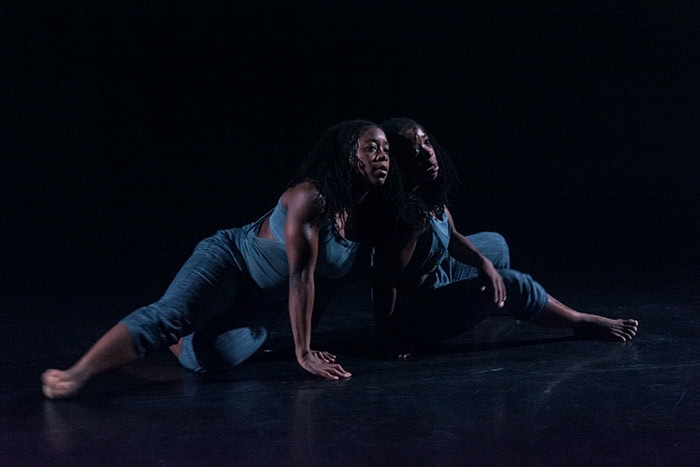Alleyne Dance, A Night’s Game
Posted: April 2nd, 2022 | Author: Nicholas Minns & Caterina Albano | Filed under: Performance | Tags: Alleyne Dance, Certain Blacks, Eric Williams, Kristina Alleyne, Lucy Hansom, Roy DeCarava, Sadé Alleyne, Salvatore Scollo, Shipbuilding | Comments Off on Alleyne Dance, A Night’s GameAlleyne Dance, A Night’s Game, Rich Mix, February 18, 2022

A couple of weeks before seeing Alleyne Dance in A Night’s Game at Rich Mix I saw an exhibition of photographs at David Zwirner Gallery by the late Roy DeCarava, a New York-based African American artist whose monochrome prints recorded predominantly the lives of people and the neighbourhoods of his native Harlem in the 1940s and 50s. What struck me about the prints, quite apart from his empathy for his subjects, was that DeCarava appeared to calibrate his register of shades between black and white from the darker end of the scale, from the colour of the skin he was photographing. Being a master printer, he was able to bring out the colour of his subjects in relation to their socio-economic and physical environment.
Seeing the Alleyne sisters so soon after was to rekindle DeCarava’s vision in performance; for a start, A Night’s Game is conceived in shades of black and white that reach towards the darker end of the scale, and it employs an additional register of sound —an eclectic array ranging from ambient sources to Ólafur Arnalds — that serves as the aural site in which the work is set. The work begins in total darkness intensified first by the sound of whispering and then by rhythmic body percussion; as Salvatore Scollo’s lighting levels gradually rise we see and hear a seated Sadé Alleyne beating out something between a syncopated slave rhythm and ritual self-flagellation. It is a tour de force she expresses in unsparing shades of fear: she lies back in pain, looks around in apprehension and thrusts her pelvis forward in a taught bow-like gesture of vulnerability that lasts just long enough to register before snapping back into a frenzied muscular argument. She stops to gain her breath then starts again with a doubling down of frustration until she seems to surrender to the weight of her hands and arms in despair. Like DeCarava’s vision, we experience not only the visual registers in A Night’s Game but feel their psychological counterpart.
The program note informs us that A Night’s Game is ‘inspired by real-life stories of imprisonment, escape and fighting for freedom. It reflects the turmoil and strife that comes with the prospect of incarceration.’ All art is political, and A Night’s Game is no exception, but its political message is presented as it were from within; rather than a statement of opinion it is one of vicarious experience that demands an end to entrapment and puts the audience on jury duty. It’s un uncomfortable position to be in, all the more so because Sadé draws you into her testimony with such conviction. Like a trial, all the evidence of A Night’s Game — gathered in verbal interviews and presented in physical form — is collected for the benefit of the audience on behalf of those who endure systemic social and racial injustice. What Sadé and her twin sister Kristina invoke in these untold histories is the implicit link between incarceration, racial discrimination and social inequality. As Eric Williams wrote in Capitalism and Slavery, ‘slavery was not born of racism: rather, racism was the consequence of slavery.’ A Night’s Game is putting history itself on trial.
When Kristina first arrives on stage there is some reprieve but not much — or perhaps we are just hoping there would be — for she soon takes over where Sadé left off until the two join forces; in the language of bodies, their close communication both entangles and supports them to the point of exhaustion. They scuffle, throw chairs to each other and find kinship in a dreamlike duet that in its synchronicity and adversity indicates a form of bargaining, like writing on the ground with their bodies. This constant advocacy on behalf of those who face the loss of freedom or who have already lost it — the ‘bodies of evidence’ — rises to a climax of rage and indignation in the form of exhaustive solos that not even the final dimming of the lights can lessen. It is worth mentioning that Kristina is almost five months pregnant but there is never a sense that she is holding herself back; to do so would be to compromise the dual thrust from which A Night’s Game derives its singular integrity and force.
A Night’s Game is one of four shows that comprise Shipbuilding, a performance festival from Certain Blacks that has been created in response to the UK’s societal climate.